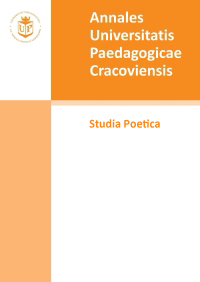Sanok i Brugia – peryferyjne miasta Mariana Pankowskiego
Sanok and Brugge – the peripheral towns of Marian Pankowski
Author(s): Krystyna LatawiecSubject(s): Language and Literature Studies, Comparative Study of Literature, Polish Literature
Published by: Wydawnictwo Uniwersytetu Komisji Edukacji Narodowej w Krakowie
Keywords: peripheral topics;urban images;subjective expression;eccentricity;Polish Romanticism
Summary/Abstract: The article presents an analysis of two urban images pictured in Marian Pankowski’s prose. His home town, Sanok, being the town of his youth, is shown in his experimental novel Matuga idzie (Here comes Matuga) dating to 1956-57, while the medieval Brugge is presented in Putto, written in 1994. The former is the place of the writer’s initiation in the nature and sexuality, while the latter, with its architecture, brings to mind the old painters’ engravings and thus shows as a product of high culture. The writer does not aim at a realistic reconstruction of space, but treats it as a pretext to argue with the fossilized forms which limit the subjective expression of an individual. In the first novel mentioned, he revises the Romantic sense of national community, while in the Belgian novel he discloses the appearances of the bourgeois world order. In both cases the writer surfaces the hidden complexes by reaching to the sphere of the Night, as he calls this subcutaneous world. He explores peripheral topics and moves beyond the ordered urban landscape towards the phenomena difficult to rationalize. He confronts the subjective ”self” with the disenchanted post-War world. He triggers a clash between the youthful idealism and the difficult knowledge elicited from the political history lesson and from the observation of contemporary social behaviours. He is inclined to adopt the subjectivist perspective and manifests individualism and eccentricity. He questions the fossilized beliefs in the name of the truth of body and senses. Owing to this, he gains distance towards the mainstream of Polish Romanticism. However, he remains a follower of the Romantic project of consciousness regarded as the expressive and creative principle. He demonstrates it when he deprives the well-known topoi of the ”family Arcadia” or the ”idyllic childhood” of their aura of familiarity. He leads his hero out of cosy places to throw him against what is alien, unbelievable, or perverse. The accompanying feeling is that of ethic and cognitive uncertainty: an integral element of the human condition. This pessimistic interpretation is not a negative conclusion with respect to this writer. If critical thinking is believed to shape individual separateness, then Pankowski’s prose is evidence of individualistic inventiveness, rooted in the Romantic spirit. In an artistic strategy designed so, the urban images are a projection of the subjective ”self”, which respects their material reality, but at the same time inscribes in them its own emotions.
Journal: Annales Universitatis Paedagogicae Cracoviensis. Studia Poetica
- Issue Year: 3/2015
- Issue No: 1
- Page Range: 9-22
- Page Count: 14
- Language: Polish

